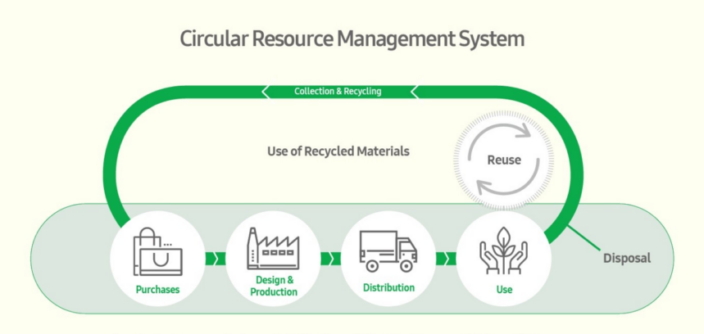Applying Samsung’s Innovative Spirit to Eco-Friendly Product Design
on June 5, 2017
Samsung is committed to minimizing the environmental impact of its innovative products, which include smartphones, TVs and much more. As part of this commitment, Samsung has developed various unique, eco-friendly design processes. In celebration of World Environment Day, here is a deeper look at Samsung’s comprehensive efforts.
Reduce, Reuse, Recycle
The keys to conservation are simple: reduce, reuse, recycle. Samsung applies these fundamental principles to product design by employing a system of circular resource management. Or, in layman’s terms, by mapping out a lifecycle of sorts for the devices it develops.

In a nutshell, Samsung aims to minimize its products’ environmental impact by maximizing resource efficiency from assembly to eventual disposal. This entails reusing parts, utilizing recycled packaging and plastics, and increasing the recyclability of new products’ components for later use.
A Green Stamp of Approval
In 2005, Samsung established in-house processes to ensure the eco-friendliness of its products from the development stage, and in 2014, the company instituted a proprietary system to assess the ecological merits of each product with an ‘eco-rating’.
The system’s three ratings – Eco-Product, Good Eco-Product and Premium Eco-Product – take into account each country’s eco-labeling standards, evaluating a wide range of criteria concerning a product’s compliance with energy and resource efficiency regulations, as well as its environmental impact.
As of the end of 2016, approximately 86 percent of Samsung products in development had attained ratings of Good Eco-Product or higher. This year, Samsung plans to revise its in-house evaluation formula to also incorporate the eco-labeling criteria of external accreditation bodies. The goal is to ensure that by 2020, 90 percent of Samsung products in development reflect the highest eco-labeling standards.
A Roadmap to Reduce GHG Emissions
In 2014, Samsung laid out a comprehensive roadmap to reduce greenhouse gas (GHG) emissions in both the manufacturing process as well as in the product use stage.
At the product use stage, the goal is to achieve a cumulative reduction of 250 million tons of GHG emissions by 2020. Samsung intends to reach that magic number by taking innovative measures to improve its products’ energy efficiency – measures that, thus far, have yielded encouraging results. In fact, the company’s actions resulted in a reduction of approximately 188 million tons of accumulated GHG emissions from 2009 to 2016.
At manufacturing sites, Samsung aims to reduce GHG intensity levels by 70 percent (compared to 2008) by 2020. The company has made considerable headway on this goal by optimizing its global manufacturing sites and production facilities’ energy efficiency, and treating emissions, such as fluorinated greenhouse gases, that are generated during the production process.
More Eco-Friendly Every Year
In addition to reducing GHG emissions, Samsung is constantly exploring innovative ways to eliminate the use of hazardous substances in the manufacturing process. These measures not only lead to safer work environments, but safer products overall.
Over the past several years, Samsung has reduced its use of a range of hazardous substances commonly used in electronics manufacturing. As a result, products including Samsung’s latest TVs and smartphones are free of widely used but potentially harmful substances including PVC, a common synthetic plastic, flame retardants such as TBBP-A and BFRs, and phthalates.

Samsung’s commitment to reducing its devices’ environmental impact is responsible for QLED TV’s groundbreaking cadmium-free design. In addition, the recently released Galaxy S8 and S8+ have also been lauded for being especially environmentally friendly, having achieved ECOLOGO Gold certification to the ANSI/UL 110 sustainability standard.
The distinction – awarded by UL Environment, a division of Underwriters Laboratories, a global safety science company – evaluates criteria including a device’s energy efficiency, charging systems, use of post-consumer recycled and bio-based plastics, and ease of disassembly.
Samsung innovations have consistently attained such ‘green’ certifications. In total, as of the end of 2016, 2,054 Samsung models had been awarded eco-label certifications from governments and accreditation bodies the world over.
A Growing List of Green Innovations
Samsung’s flagship devices represent just the latest additions to a lengthy list of accolades the company has garnered for going green. Governments and environmental organizations around the globe have lauded Samsung with awards for an array of eco-friendly products, and in recognition of the well-rounded, ‘circular’ system of resource management mentioned above.
The system’s goal is not to simply manufacture cutting-edge devices in a responsible way, but to ensure the same eco-efficiency at the latter stages of the device’s lifecycle – namely everyday use and eventual disposal. Samsung’s commitment to green design at each product stage has seen the company minimize the eco-footprints of some of its most dynamic innovations.
These extensive efforts have led leading environmental authorities such as the U.S. Environmental Protection Agency (EPA) to consistently honor Samsung for its responsible, energy efficient designs. These sustainability-minded distinctions encompass a wide range of categories and products including, most recently, the aforementioned cadmium-free Quantum dot technology behind Samsung’s TVs.
Properly addressing tomorrow’s environmental challenges requires manufacturers to carefully consider how their products will ultimately be recycled. Samsung’s foresight in this aspect of design has also garnered consistent accolades, including last year’s Design for Recycling Award from the Institute of Scrap Recycling Industries (ISRI).
Samsung earned the distinguished honor, which recognizes a single brand who exhibits exceptional consideration for product recyclability, for its Curved Full HD TV (UN55K6250). The TV is the first to utilize polyketone, a plastic made from converting carbon monoxide, and its streamlined design allows it to be easily recycled.
Other commendations that Samsung received last year for eco-friendly innovations are outlined in the chart below.

The company’s current range of eco-offerings encompasses its smartphones, TVs, digital appliances and other products.

Going forward, Samsung will continue to develop exciting eco-friendly innovations that demonstrate the merits of going green in product design, and will ultimately help preserve our planet for future generations.




